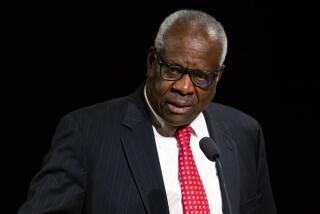Tobacco Industry Unharmed by Landmark Defeat in Smoker Death Case : Lawsuits: The number of claims has fallen since the $400,000 judgment. Later legal rulings stand to benefit cigarette firms.
Eighteen months after the tobacco industry suffered a landmark defeat in a smoker death case, the number of lawsuits against cigarette makers has actually dropped, and the legal calamity predicted by some of their foes is nowhere in sight.
After flicking away damage suits for 35 years, the industry’s unbeaten record was shattered in June, 1988, when a jury in Newark, N.J., returned a $400,000 verdict against Liggett & Myers for the lung cancer death of Rose Cipollone.
Industry critics were ecstatic and predicted that the cigarette makers, like asbestos companies, would soon be buried in an avalanche of suits. With an estimated 350,000 smoking-related deaths per year, they argued, there would be no shortage of potential plaintiffs.
Tobacco officials, in an attempt at spin control, declared themselves the victors. The jury, they said, had rejected the most damning claims against them. More important, the Cipollone lawyers lost so much money on the case that other plaintiff lawyers would be scared away.
It seemed like mere bravado, meant to soothe the nerves of anxious stockholders.
But a year and a half later, there is evidence that tobacco officials were right:
--The number of lawsuits pending against tobacco companies has dwindled from about 90 at the time of the Cipollone verdict to about 60 today.
--The cases have moved at glacial speed, with only one coming to trial since Cipollone--and that ending in victory for the industry.
--Both before and since the Cipollone verdict, key federal appeals court rulings and new laws in some states, including California, have significantly strengthened the industry’s hand by preventing certain claims from being brought before juries.
Even tobacco stock prices, traditionally depressed by fears of liability suits, have risen sharply since the Cipollone verdict and have “dramatically outperformed” the rest of the market, as one analyst put it.
Rulings in closely watched appeals and trials could change the current outlook. But up to now, “the tobacco companies have done just fine,” said Calvert Crary, managing director of Labe, Simpson & Co., a New York investment firm. “Sure they lost one, but they seem to have managed to persuade most of the lawyers in the plaintiffs’ bar that there’s nothing there.”
Donald Garner, a Southern Illinois University law professor and authority on tobacco litigation, compared the litigation to “a tumor” in the industry that “isn’t in total remission, but so far so good.”
“It’s almost like it’s (tobacco litigation) frozen in an ice cube,” said Victor Schwartz, a Washington, D.C., product liability expert and counsel to the Product Liability Alliance, an industry group that includes tobacco companies. “It isn’t gone, but it isn’t moving forward,” and for the cigarette makers, “No news is good news,” Schwartz said.
But Richard Daynard, a law professor and head of the Tobacco Products Liability Project in Boston, a support group for attorneys who sue tobacco firms, said the holding pattern is temporary. “Clearly things are quiet now, but there have been other quiet periods,” Daynard said.
In the long run, he argued, wealthy and sophisticated law firms “can do spectacularly in this field, as well as making a real contribution to the public health.”
There’s little doubt, however, that the Cipollone victory scared off the main-street practitioner. The $400,000 judgment cost the Cipollone lawyers at least $2 million in expenses and time, and it remains to be seen if the award will stand up on appeal.
“I do not believe the plaintiffs’ bar views these cases as holding significant profits for them,” said Chuck Wall, an attorney with Shook, Hardy & Bacon of Kansas City, which represents industry leader Philip Morris Inc., along with Lorillard Inc. and the Tobacco Institute. “I would think that the cases would continue to dwindle in the foreseeable future.”
According to some estimates, Liggett, Philip Morris and Lorillard, whose brands Rose Cipollone smoked, spent at least $50 million defending her lawsuit, a figure the companies won’t confirm or deny.
In a shrinking market, U.S. cigarette makers this year racked up domestic sales of $39 billion. Their most potent legal weapon always has been a huge cash flow, an advantage that did not change with the Cipollone verdict.
Of more than 300 suits filed against them since the 1950s, tobacco firms have had to defeat only about a dozen at trial, as many ended when financially exhausted plaintiffs threw in the towel.
As a lawyer for R. J. Reynolds said last year in an unusually blunt memo leaked to The Times, the industry’s hardball tactics have made the litigation “extremely burdensome and expensive for plaintiffs’ lawyers. . . . To paraphrase Gen. (George) Patton, the way we won these cases was not by spending all of Reynolds’ money, but by making (the enemy) spend all his.”
Perhaps more important for the industry, a series of federal court rulings and state legislative acts during the past three years have limited the claims of dying smokers and survivors of deceased smokers.
Five separate U.S. Circuit Courts of Appeals have ruled that the congressionally mandated warning label placed on cigarette packs in 1966 shields the industry from claims that it failed to adequately warn smokers of the risks they took. In essence, critics say, the industry was made immune from liability for deceptive ads and false statements, so long as it put the right words on each package. Even so, the rulings caused some cases to be dismissed and kept others from being filed.
A few states have also redesigned the playing field to the industry’s advantage. During the last two years, changes in product liability laws in New Jersey, Ohio and Louisiana bar some types of claims against cigarette makers.
But the most sweeping change was adopted by California lawmakers two years ago and upheld last May by the state Supreme Court. It bars damage suits against manufacturers of cigarettes or other products that are “inherently unsafe and . . . known to be unsafe by the ordinary consumer.” In California, suits against the tobacco giants have dwindled from about 30 two years ago to zero today.
Time also is on the industry’s side, since the pool of “worthy” plaintiffs will shrink as years go by. The most sympathetic plaintiffs will be those who started smoking as teen-agers in the 1940s or ‘50s, were bombarded with ads promoting smoking as healthy and suave and were addicted by the time of the surgeon general’s warning.
By contrast, smokers who took up the habit after the surgeon general’s warning stand little chance of winning a claim, most experts believe. As time goes by, a higher proportion of smoking-related disease will afflict these newer smokers.
If the industry can “beat these cases down for another 10 years, I think cigarette litigation is just going to be virtually impossible to resurrect,” said Garner, the Southern Illinois University professor.
After a quiet 1989, the legal battle is expected to heat up again in 1990. A decision on the Cipollone appeal is expected, and two smoker death trials are scheduled for early in the year after more than a year without any.
Kotler vs. American Tobacco, brought by the widow of longtime smoker George Kotler, who was 55 when he died of lung cancer in 1986, is scheduled for trial Jan. 3 in Boston.
And the long-awaited retrial of Horton vs. American Tobacco is set for April in Mississippi. Nathan H. Horton died of lung cancer at age 50 after smoking American’s Pall Mall brand, and his family’s lawsuit against American ended in a hung jury in January, 1988. Coming a few months before Cipollone, Horton was the first smoker death trial that did not end in outright victory for the industry.
More to Read
Inside the business of entertainment
The Wide Shot brings you news, analysis and insights on everything from streaming wars to production — and what it all means for the future.
You may occasionally receive promotional content from the Los Angeles Times.










